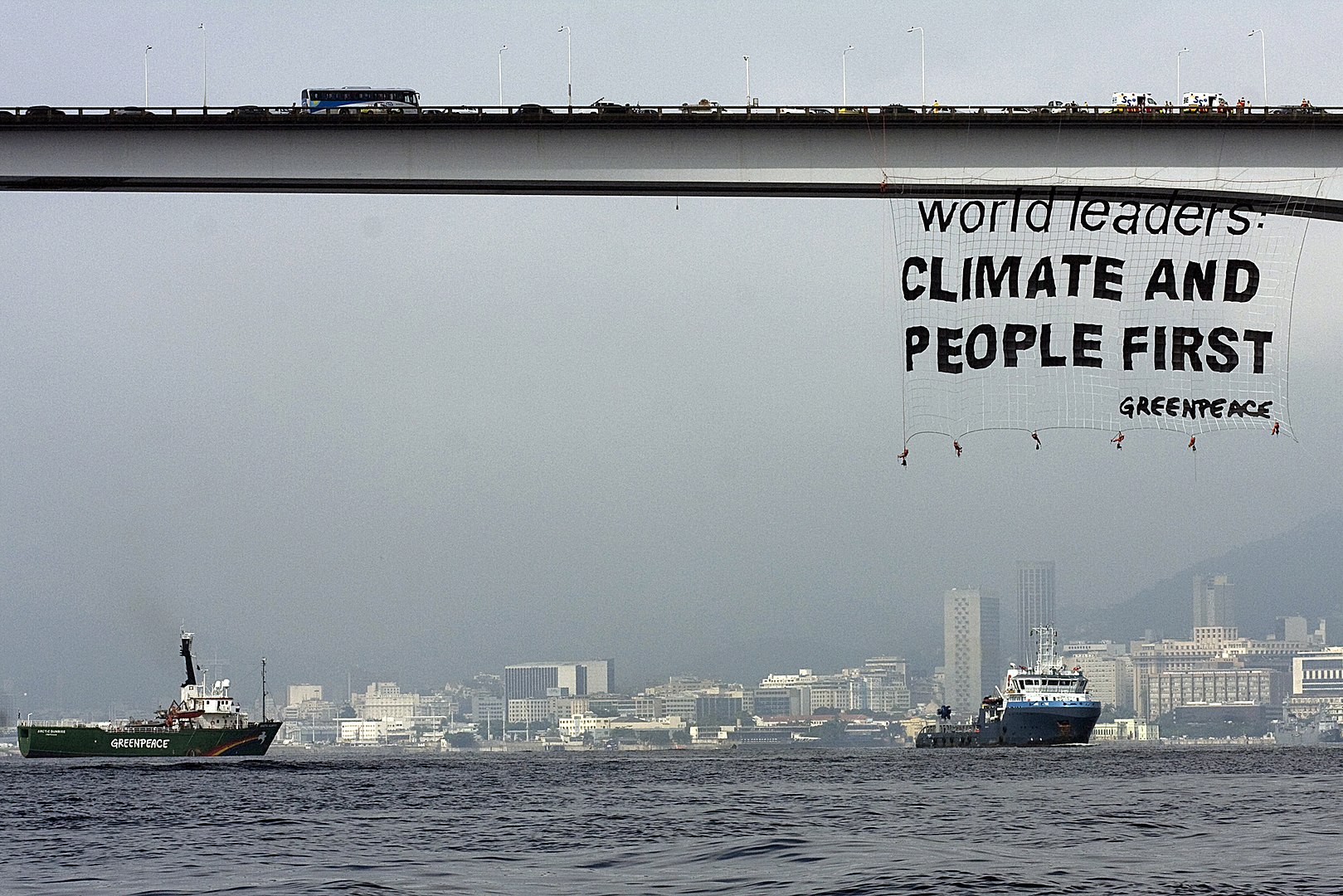Lorem ipsum dolor sit amet, consectetur adipiscing elit. Ut elit tellus, luctus nec ullamcorper mattis, pulvinar dapibus leo.
Neat to know ~ Feature of the week
Lorem ipsum dolor sit amet, consectetur adipiscing elit. Ut elit tellus, luctus nec ullamcorper mattis, pulvinar dapibus leo.
Greenpeace
50 years of environmental activism

Greenpeace activists in Rio de Janeiro, Brazil, in 2009, ahead of the G20 in London
Photos: Alex Carvalho, CC BY-SA 2.0
2021-01-12
The iconic environmental organization, Greenpeace, got started in 1971, when a small group of concerned citizens in Vancouver, Canada, decided to protest nuclear testing by the United States on Amchitka Island in the Bering Sea. They took a small boat and headed to the island – a dangerous mission. At some point, they were stopped by the U.S. Coast Guard. But their courage and passion made world headlines, and shined a spotlight on an issue many people had not known much about.
Since this single act of peaceful protest almost 50 years ago, Greenpeace has grown into a renowned international organization. It has millions of members and offices in dozens of countries. Its mission is to raise awareness about environmental degradation around the planet and to propose solutions. The organization is largely sustained by the financial support of its members. It is staunchly independent and does not affiliate itself with any corporations or political parties.
Greenpeace principles
- Greenpeace seeks to educate people by shining a light on what corporations, governments, and individuals are doing to hurt the planet. The organization relies on scientists investigating problems and understanding the damage done, as well as the consequences of that damage, on a deep level. Greenpeace strives to ensure that no one gets away with destructive acts against the environment without us knowing about it. It also tries to make sure that those groups or individuals whose practices endanger the health of our planet are held accountable for their actions.
- Supporters of Greenpeace can take part in a variety of ways. Many contribute money to fund projects, research, and campaigning efforts. Some are more action-oriented and might go to the sites of environmental abuses to take a physical stand. Others take action on a smaller, though no less important, scale. For instance, they boycott stores that use throwaway plastic bags and post information and petitions on social media. They march in climate protests and write to their representatives in government. They vote for politicians who pledge to prioritize the environment. They also buy products from companies that have the smallest ecological footprints.
- Non-violence is a key tenet of Greenpeace’s approach to activism. So, even though the organization is dedicated to direct action, which can get confrontational at times, activists are never violent. Raising public awareness through media coverage of their often dramatic acts of protest is an important part of the Greenpeace strategy.
- On its website, Greenpeace states, “Through our campaigning, we create solutions that promote environmental sustainability rooted in social justice.” The organization views the protection of human rights and equality as part of its work protecting the Earth.
Greenpeace campaigns
Greenpeace is involved in countless projects around the world. Here are a few ongoing campaigns, broadly described.
- Global warming – raising awareness about the climate crisis, particularly as it is tied to the burning of fossil fuels like coal and oil.
- Farming – making sure that crops and animals are raised humanely and sustainably and in ways that do not destroy the land or pollute the air and water.
- Oceans – stopping the dumping of plastic and other pollutants into the seas; demanding that companies reduce their use of plastic, particularly in packaging.
- the Arctic – opposing the drilling for oil by governments and companies in the Arctic region; raising awareness about the dramatic and swift ways in which climate change is destroying the Arctic.
- Rainforests – opposing deforestation.
For a specific example of a successful campaign, we can go back to 2014. The toy maker, Lego, was partnering with Shell, a big oil company that was drilling for oil in the Arctic. Greenpeace launched a major campaign to pressure Lego to cut ties with Shell. A video it put out for the campaign, was viewed by millions and quickly went viral. Children took action by building models of enormous Arctic animals out of Lego and placing them in front of Shell headquarters in London. A million people sent letters and emails to Lego to stop dealing with Shell.
Sure enough, the toy maker listened, as a direct result of the pressure from Greenpeace and its supporters, and broke its connection to the oil company.
Sources: Greenpeace.org, https://www.greenpeace.org/usa/about/; Encyclopaedia Britannica, “Greenpeace: International Organization,” https://www.britannica.com/topic/Greenpeace; National Geographic Kids, “Explore the Earth with Greenpeace!” https://www.natgeokids.com/save-earth-with-greenpeace/; Vaughan, Adam, The Guardian, “Lego ends Shell partnership following Greenpeace campaign,” https://www.theguardian.com/environment/2014/oct/09/lego-ends-shell-partnership-following-greenpeace-campaign, October 9, 2014.